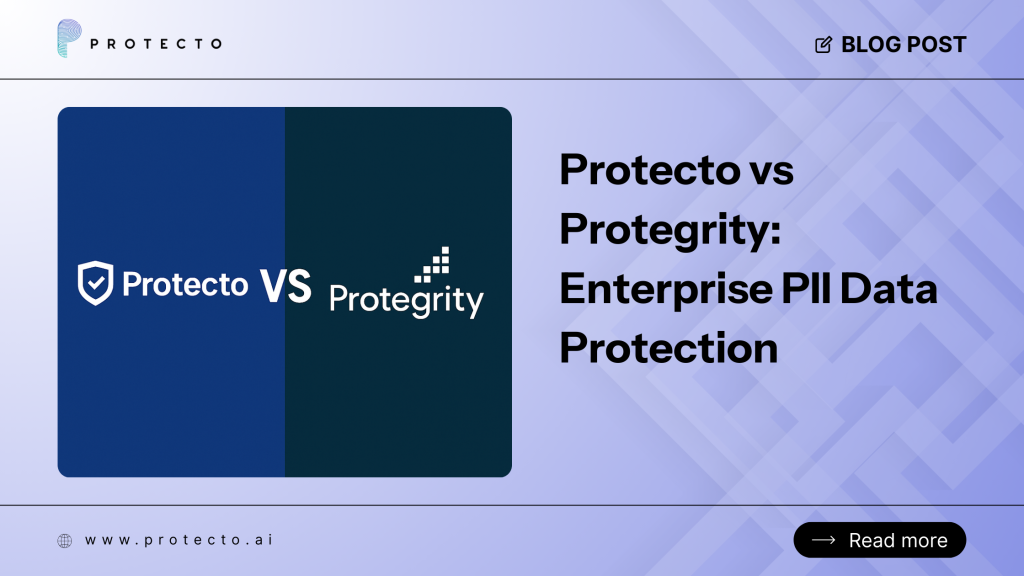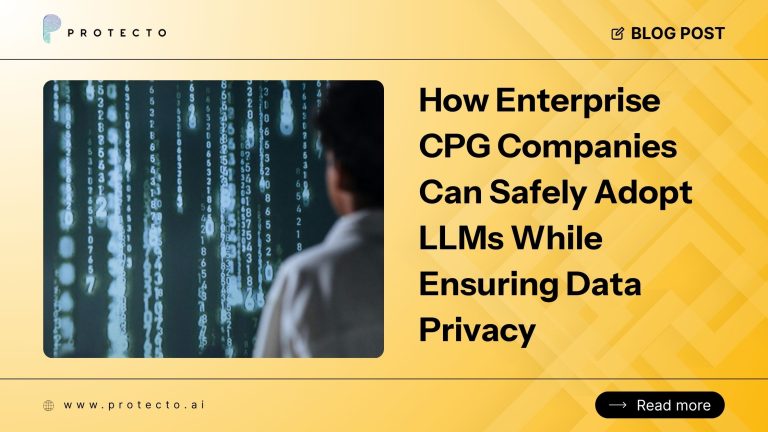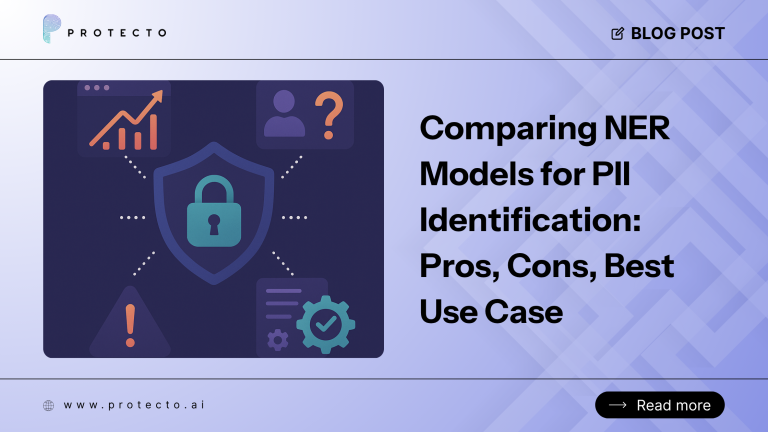If your business shares sensitive data with a third party, AI agents, obliged to follow data residency laws, or ensure access control within their databases, you must use a data privacy tool.
IT teams and product managers evaluating data privacy tools often run into a similar challenge: which is the right product? Two notable contenders, Protecto and Protegrity both offer enterprise-grade solutions but with distinct approaches.
This comparison examines features like detection accuracy, deployment complexity, integration options, performance, and compliance support to help you choose the right tool.
Protecto vs Protegrity: Tokenization Capabilities
Both Protecto and Protegrity offer tokenization for sensitive data. The way it is handled can make a difference in terms of making or breaking your AI. Let’s explore how each makes a difference:
Protecto |
Protegrity |
| Tokenization via API | |
| With Protecto users can call its REST API endpoint, provide the data and specify which tokenization policy to apply.
APIs give users the flexibility to integrate it easily with any existing systems with less time and effort. This flexibility ensures consistency in tokenization and meets compliance requirements easily by enforcing policies through the API layer. |
Protegrity’s API uses Azure Functions in a cloud deployment where a specified data element corresponds to a tokenization policy. The response returns the tokenized results.
Protegirty’s APIs are tightly bound to Azure. This reduces the depth of integration in complex, hybrid cloud setup. Users may feel friction in maintaining consistency in tokenization, resulting in incorrect output or accuracy in data analysis. |
| Batch Tokenization | |
| Protecto provides an asynchronous batch API – you can send a large payload or a set of records to tokenize. This is efficient for high-volume processing because it doesn’t require calling the API for each individual record. IT teams can save time and effort by sending a large payload once. | Protegrity can also handle batches, its architecture might spin up multiple function instances to handle the load |
| Format-Preserving Tokenization | |
| Protecto allows tokens to be generated that look like the original format. An email will look like an email address, or a phone number token will have the same number of digits.
For example, Norman James Doe becomes <PER>jahsdh hdhs kjashk</PER>. This way, AI knows the context and retains it, ensuring scalability, performance, and integrity, unlike masking tools that distort data beyond usefulness. Another key advantage is that users need not change their existing database schemas to accommodate tokens. In addition, intelligent, entropy based tokenization ensures strong anonymization to lower re-identification risk. |
Protegrity also supports format preserving techniques using Format Preserving Encryption (FPE) technique. For example, Steven Gregor will become NSQkxl SSwqdf, retaining the space and number of words.
While the format was retained, context was missing – AI does not know if this is a name, or city, or any other PHI/PII. Lack of context results in poor quality of analytics. Protegrity uses a vaultless, algorithmic token generation using static codebooks. It balances scalability and performance but it is less secure compared to entropy based tokenization. |
| Deterministic Tokenization | |
| Protecto uses deterministic tokenization, meaning every time “John Doe” appears, it gets the same secure token.
For example, alice@example.com always becomes <EML>3ikKb@Q9ZMI5B</EML>. This consistency ensures that the model trains on sanitized yet structurally intact data to preserve utility while neutralizing risks like poisoning attempts relying on inconsistent patterns. |
Protegrity supports deterministic tokenization, and its policies allow users to choose between purely random or repeatable per input.
However, as previously outlined, AI needs context to generate correct, accurate output. Even if the format retains, without context, AI breaks. |
| Custom Tokenization | |
| Protecto lets you define tokenization policies that specify the token type (e.g., an “email token” vs “name token”) and the format to preserve certain characters or patterns.
For instance, you could keep the country code the same but randomize the rest. The flexibility is there to support various data types. |
Protegrity offers vaultless tokenization, classic encryption, and static masking for non-production data. Their APIs let users define Data Elements which encapsulate how a certain kind of data is to be protected. |
Protecto vs Protegrity: Deployment, Configuration, & Pricing
A major consideration is the ease of deployment and integration of each solution across your IT environment. This includes initial provisioning, setting up across multiple environments, upgrading, and handling day-to-day configuration.
| Protecto | Protegrity |
| Deployment | |
| Protecto is designed as a cloud-native application and runs on container platforms like Azure services, Azure Container.
Protecto team provides clear documentation, and because it’s built for the cloud, a lot of the process can be automated. Protecto’s install is environment agnostic – there were some manual steps but could easily be wrapped into automation. |
Protegrity’s deployment is more involved. Multiple components need to be installed and configured with the help of professional services or detailed guides.
Because there are more moving parts, initial provisioning requires careful setup of many items like Linux user accounts on the VM, an App Registration in Azure AD, function app settings and keys, Key Vault entries. The company provides engineers to help with custom Infrastructure-as-Code, but out-of-the-box automated deployment scripts are not provided, requiring manual effort. |
| Policy management | |
| Users can use APIs or scripts to recreate policies in each environment without any manual effort. Role and region-based access controls allow only authorized users to unmask data after AI processing. | Allows policy management via its APIs. It’s doable to integrate that into a CI/CD flow, but it requires manual intervention for scripting those API calls, slowing down the setup timeline. |
| Disaster Recovery | |
| Protegrity inherently uses a vaultless tokenization design, which means it doesn’t rely on a central database of token mappings that could be a single point of failure. It utilizes a datastore to keep token data or keys. | In a typical Protegrity production deployment, you’d have a cluster to ensure the tokenization service is always up. Since there is no vault to back up, disaster recovery involves backing up the configuration, by exporting a policy file or taking snapshots of the management VM. |
| Pricing modules | |
| Protecto offers a more cost-effective pricing structure, with its annual subscription ranging roughly $110k–$170k/ year for an enterprise license. It varies based on data volume or number of servers, but it tends to be significantly lower than Protegrity.
The lower cost, combined with fewer infrastructure requirements, means the total cost of ownership for Protecto attracts mid-sized companies or those starting their data security journey. Additionally, the lower complexity translates to fewer hours spent on deployment and management. |
Protegrity comes at a premium. Typical annual costs are around $300k–$350k per year for similar scopes. Large organizations may negotiate custom deals, but expect it to be a sizable investment.
For industries where fines for data breaches are massive, an expensive solution can be worth it. However, smaller SaaS companies or cost-sensitive teams might find Protegrity’s price tag hard to swallow given that Protecto can cover the basics and offer much more for a fraction of the cost. |
Protecto vs Protegrity: Sensitive Data Detection & Classification
Large organizations often don’t know exactly where all their personal data resides. Both Protecto and Protegrity offer automated discovery of sensitive data, but minor differences in data identification set them apart.
| Protecto | Protegrity |
| PII & PHI Identification | |
| Protecto automatically scans, classifies, and maps PII, PHI, PCI from structured and unstructured data sources.
Protecto’s intelligent system understands context to reduce false positives. For example, it could distinguish a random 16-digit number from a real credit card pattern, or it could find addresses hidden in sentences. Once identified, it can tag or catalog these sensitive data elements. |
Protegrity also offers a sensitive data discovery module that uses ML-powered discovery tools to find PII, PHI, and PCI across structured data. However, it cannot handle unstructured sources.
Protegrity’s lack of ability to understand context while discovering sensitive data underscores its position as an enterprise platform covering end-to-end data security |
| PII & PHI De-Identification | |
| Protecto combines entropy-based deterministic tokenization and a secure privacy vault to de-identify sensitive data. Once detected, those values are replaced with deterministic tokens.
For example, “John Doe” might consistently become USR_12345 across every system, reatining data structure and relationships without exposing the real identifier. Users can analyse large datasets without unmasking. The vault holds the original mapping; the AI system only sees tokens, while re-identification is possible only in secure, controlled workflows. |
Protegrity takes a different approach with vaultless, format-preserving tokenization. Instead of storing mappings in a vault, Protegrity uses deterministic cryptographic algorithms to replace sensitive data with values that “look real.”
Because no vault is required, de-tokenization depends on cryptographic keys and the algorithm itself. If someone has the right keys, the data can be restored. |
Protecto vs Protegrity: Governance, Compliance, and Ease of Use for Admins
Beyond simply tokenizing data, organizations must also manage who can view the data, who can tokenize/detokenize it, and how to audit its usage. Additionally, they must ensure that all these processes align with compliance requirements. This is where governance features come in.
| Protecto | Protegrity |
| User Access and RBAC | |
| Protecto enforces RBAC by acting as a policy-aware gateway around your LLM and sensitive data flows.
Unlike most tools that rely on the model to “understand” permissions, Protecto evaluates every request and response in real time, applying the same principles that you’d normally use in databases or SaaS apps. This way, customers can avoid maintaining a separate set of permissions. |
Protegrity has a built-in RBAC and policy enforcement mechanism. In the Protegrity Security Console (ESA), an admin can define user groups and roles, and assign permissions on different “Data Elements” or operations. You need to set up separate access permissions. |
| Audit Logging and Reporting | |
| Protecto logs details on every tokenization or detokenization API call – which user or API key made the call, what data element was accessed, etc. Dedicated audit trials separate research projects for different healthcare centres.
Protecto’s strength is that every call is inherently logged by its microservice; one just has to capture those logs. |
Protegrity provides some level of audit reporting in its console. It likely can show things like “how many credit card numbers were tokenized this month” or “which users performed detokenization and how often”. This, however, fails to paint a comprehensive picture.
By default, not everything is logged in detail until configured. So there might be a bit of setup to get comprehensive logging in Protegrity. |
| Scalability of Governance | |
| Protecto keeps things simple: you could have a policy per data type and apply it everywhere via the API. Protecto implicitly protects whatever you funnel through it, and it’s up to you to ensure coverage. For a fast-moving tech company, this approach is more adaptable |
Protegrity maintains a mapping of possibly every protected column in its system. Their config can become quite large and complex – ultimately making it unmanageable. However, it’s centralized and enforceable with the help of internal teams. |
In summary..
Protegrity vs Protecto, which is right for you? Let’s summarize the capabilities and features to help you make a decision.
| Feature | Protecto | Protegrity |
| API-first tokenization | ✅ Yes – REST APIs, flexible and easy to integrate | ⚠️ Yes, but – API tightly bound to Azure Functions |
| Format-preserving tokenization | ✅ Yes – tokens retain context & format for AI/analytics | ⚠️ Yes, but – retains format but lacks context for AI |
| Deterministic tokenization | ✅ Yes – consistent tokens for same input | ✅ Yes – deterministic supported, but context issues remain |
| Custom tokenization policies | ✅ Yes – highly flexible (define token type, patterns) | ⚠️ Yes, but – vaultless tokenization with less flexibility |
| Cloud-agnostic deployment | ✅ Yes – containerized, works across any cloud or on-prem | ❌ No – primarily optimized for Azure, less depth elsewhere |
| Unstructured data detection | ✅ Yes – detects structured & unstructured data with context | ❌ No – mainly structured data, weak on unstructured/context |
| Easy deployment & automation | ✅ Yes – lightweight, quick to deploy, automation-friendly | ❌ No – complex, heavy setup, manual provisioning needed |
| Strong governance & RBAC | ✅ Yes – API-driven RBAC & policy enforcement | ✅ Yes – strong enterprise RBAC, but complex to manage |
| Detailed audit logging | ✅ Yes – logs every tokenization/detokenization call | ⚠️ Yes, audit logging exists, but it requires extra setup |
| Scalability & performance | ✅ Yes – cloud-native, scales with distributed processing | ✅ Yes – highly scalable for enterprise & legacy workloads |




